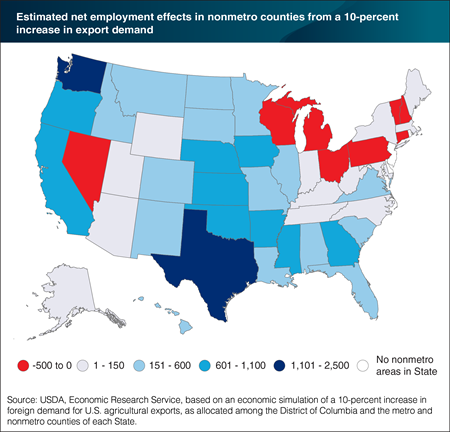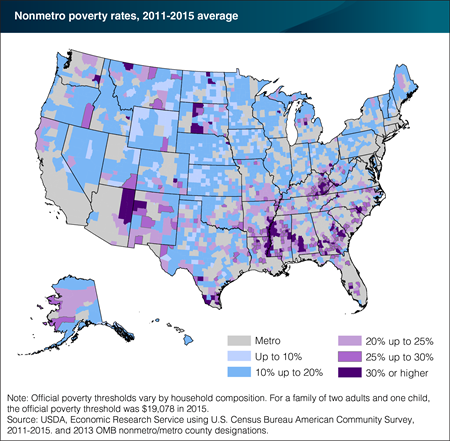Editor's Pick 2017: Best of Charts of Note
This chart gallery is a collection of the best Charts of Note from 2017. These charts were selected by ERS editors as those worthy of a second read because they provide context for the year’s headlines or share key insights from ERS research.

Tuesday, June 13, 2017
U.S. agricultural exports support about 1.1 million full-time, civilian jobs, according to 2017 ERS estimates (based on 2015 data). A recent ERS study considered how U.S. employment might be affected if the demand for these exports increased even further. To find out, ERS researchers used a computational model of the U.S. economy to explore the possible effects of a hypothetical 10-percent increase in foreign demand for U.S. agricultural products. The findings were broken apart between results for metro counties with less direct agricultural activity and nonmetro counties, where most farming occurs. Of the 47 states with nonmetro counties, 39 were estimated to gain jobs from an increase in export demand. The current level of employment in the agri-food sector (agricultural production plus food and beverage manufacturing) was a key factor in explaining the size of the simulation’s regional employment effects. There were 16 nonmetro regions where the agri-food sector accounted for more than 10 percent of total employment, ranging from nonmetro Iowa (11 percent) to Washington State (26 percent). As a group, these regions accounted for just 5 percent of U.S. employment but 32 percent of the total employment gain for the United States resulting from the simulated increase in agricultural exports. This chart appears in the ERS Amber Waves article, "Increased Demand for U.S. Agricultural Exports Would Likely Lead to More U.S. Jobs," released in June 2017.

Friday, March 3, 2017
Poverty is not evenly distributed throughout the United States. Americans living in poverty tend to be clustered in certain U.S. regions and counties. Nonmetro (rural) counties with a high incidence of poverty are mainly concentrated in the South, which had an average poverty rate of nearly 22 percent between 2011 and 2015. Rural counties with the most severe poverty are located in historically poor areas of the Southeast—including the Mississippi Delta and Appalachia—as well as on Native American lands, predominantly in the Southwest and North Central Midwest. The incidence of rural poverty is relatively low elsewhere, but generally more widespread than in the past due to a number of factors. For example, declining employment in the manufacturing sector since the 1980s contributed to the spread of poverty in the Midwest and the Northeast. Another factor is rapid growth in Hispanic populations over the 1990s and 2000s—particularly in California, Nevada, Arizona, Colorado, North Carolina, and Georgia. This group tends to be poorer than non-Hispanic whites. Finally, the 2007-09 recession resulted in more widespread rural poverty. This chart appears in the ERS topic page for Rural Poverty & Well-being, updated February 2017.

